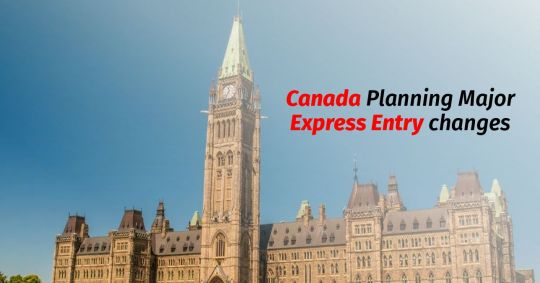#express entry system
Text
#canada#immigration#consultant#immigration services#consultant service#visa consultancy services#visa#ielts#canada immigration#migrate to canada#canada express entry#express entry program#express entry draw#express entry system#immigration experts#canada visa consultants in india#canada visa#mutual funds#visa consultants#best consultancy#best immigration consultants
4 notes
·
View notes
Text
Immigrate to Canada under the Federal Skilled Worker Program

Candidates with foreign work experience who have no ties to Canada are eligible to apply for permanent residency through the FSW program.
#Immigrate To Canada#Canada Visa Consultants#Federal Skilled Worker#Federal Skilled Worker Program#Federal Express Entry#Express Entry Draw#Express Entry System#Canada Immigration Consultants
2 notes
·
View notes
Text
Express Entry Draw 2024 #291 – Latest CRS

View On WordPress
#Best Australia PR Visa Consultancy#Best Canada PR Visa Consultancy#canada immigration#canada pr#CRS#Express Entry#Express entry draw#Express Entry Draw 290#Express Entry draw 2024#express entry system#Immigrate to Canada#Latest CRS#Latest Express Entry draw#Permanent Residence#pr#work in canada
0 notes
Text
What is the average processing time for express entry Surrey, Canada?

Introduction:
Welcome to CMC Immigration Services! As a leading provider of immigration solutions, we understand the importance of accurate information and timely updates for those navigating the Express Entry system in Surrey, Canada. In this blog, we’ll delve into the average processing times for Express Entry applications, offering insights and guidance for individuals seeking to make Surrey their new home. Read More.
#express entry#express entry system#express entry program#express entry immigration#immigration consultants#immigration#canada immigration#immigration canada#immigration expert#immigratetocanada#immigration to canada
0 notes
Text
The Role of an Express Entry Lawyer in Your Canadian Immigration Journey
Embarking on the journey to Canadian immigration through the Express Entry system can be both exciting and challenging. With complex processes and stringent requirements, having the expertise of an Express Entry lawyer can make all the difference in ensuring a smooth and successful transition to your new life in Canada. To Learn More Click Here
0 notes
Text
Top Canada Immigration Options in 2023
Even as thousands of hopeful immigrants wait for the next Canada Express Entry Draw, the country hopes to welcome 465,000 new Canada PR Visa holders in 2023. This is done in order to solve the severe shortage of skills in the job market.
The conclusion is that right now is the ideal time to start your Canadian immigration procedure. The best relocation alternatives for 2023 are briefly listed here:
Express Entry System
The Express Entry System will continue to be the major immigration route to Canada in 2023. This is the main application management system for three economic immigration programs:
Federal Skilled Worker Program
Canadian Experience Class
Federal Skilled Trades Program
In 2023, Canada intends to accept about 83,000 immigrants under the Federal High Skilled category. According to the revised Plan for Immigration Levels, the target for 2024 is 109,000, and for 2025, it is 114,000.
Under the Express Entry System, 16 new vocations are now eligible for the Federal Skilled Worker Program. This is after the National Occupational Classification for 2021, the most recent NOC, was put into effect.
The Express Entry System currently recognizes a number of new professions as qualified. These range from teachers' assistants to truck drivers, and from nurses to payroll administrators. The debut of Express Entry's targeted drawings will take place in 2023 as well.
The Canadian Parliament adopted the legislative foundation for holding such drawings in 2022. The goal is to make it possible to address certain economic labor shortages.
Provincial Nominee Program
The combined Provincial Nominee Programs, or PNPs, are the only economic immigration route that will exceed Express Entry in 2023. The PNPs are expected to admit more than 105,000 new Canadians on PR visas in 2023.
Through these PNPs, Canada will get thousands of immigration allocations in 2023. These comprise the westernmost, in British Columbia, prairie provinces of Ontario, Manitoba, Saskatchewan, and Alberta. It also comprises the four Atlantic Provinces of Nova Scotia, New Brunswick, Prince Edward Island, and Newfoundland & Labrador.
The Express Entry System is also connected to several PNP streams. It means that there is a specific stream for each PNP in the Federal Government's selection process. The targeted occupation lists and classifications need to be verified because the federal and provincial priorities might change.
Programs in Pilot Employer-Driven
Canada also manages a number of employer-driven pilot projects. These specifically target regions or sectors of the economy where there is a severe labor shortage.
At the heart of such initiatives is the Atlantic Immigration program. AIP began as an experimental initiative but has now been declared permanent. In 2023, 8,500 spots in the program will be reserved for graduates and qualified professionals from other countries. It encompasses the four provinces of Atlantic Canada: Nova Scotia, New Brunswick, Newfoundland & Labrador, and Prince Edward Island.
Another 8,500 fresh PR Visa holders are to be accepted under 3 more categories:
The Agri-Food Pilot
The Rural and Northern Immigration Pilot
The Economic Mobility Pathways Project
Since the aforementioned programs are employer-driven, applications cannot be made directly for any of them. An employer first determines a need, after which they choose an immigrant to meet it. The immigrant is then brought to Canada through any of the aforementioned programs.
Additionally, a 2023 completion date has been set for the new Municipal Nominee Program. As its name suggests, the MNP will oversee the greater localization of the immigration selection process. It will make it easier for various communities to react to the various demands of the job market.
Start-Up Visa Initiative
Canada intends to welcome 3,500 new immigrants under its business immigration programs in 2023. By 2025, there will be an increase of 6,000 people. The Start-up Visa Program will accept a sizable proportion of them.
Those applying must get the support of an angel investor group, venture capital fund, or business incubator in order to be considered. They must also be able to speak the language and have the money to relocate.
Candidates initially immigrate to Canada on a Work Permit while starting a firm, then meet the requirements for PR status. They must be actively involved in the management of the Canadian firm to be eligible.
Programs for self-employment
The Federal Government's Self-Employed Class Program seeks applicants with relevant self-employment experience. Additionally, they must be able to and want to create their own job and make a major contribution to Canada's sporting, artistic, or cultural life.
The Quebec Self-Employed Class Program seeks applicants who can establish their own employment through professional or commercial endeavors.
Also, Read About the Canada CRS Calculator to check your eligibility to move to Canada.
#canada pr visa#Canada CRS Calculator#Provincial Nominee Program#Express Entry System#Express Entry Draw
1 note
·
View note
Text

Canada held the second Express Entry draw of the year today.
ircc issued invitations to 5,500 candidates with a minimum #crs score of 490. No program was specified, meaning eligible candidates were invited from the #cec , fswp and the fstp . All are programs that operate under the Express Entry system.
Sign Up Now:
9667583755
#Express Entry system#best visa consultants in delhi#visa consultant in delhi#tourist visa consultants in nehru place#Best Tourist Visa consultants in Nehru Place#canada immigration consultants in nehru place#Visa consultancy in Nehru Place#visa consultants in nehru place#Canada PR Visa consultants in Nehru Place#best study visa consultant#best Canada PR visa consultants in Nehru Place#PR Visa Experts in Nehru Place#Canada immigration experts in Nehru Place#Canadian Immigration & visa consultants in Nehru Place
0 notes
Text

Do you wish to immigrate to Alberta but don't have a job offer? No worries. Alberta Express Entry system is here for you.
0 notes
Text
Provinces to have more control in Canada Immigration? - Aptech Visa
The provinces of Canada are attempting to reach a new immigration agreement.
The regions need to have significantly more impact on migration than the national government as Canada enters another hundred years.
The Saskatchewan government said on July 28, 2022, that it wants more control over its immigration system.
The announcement was made the same day that Jeremy Harrison, the immigration minister for Saskatchewan, and the other immigration ministers for Canada, including Sean Fraser, his federal equivalent, met in New Brunswick.
GET A FREE CANADA ASSESSMENT FORM
The ministers' agreement to create a multi-year Provincial Nominee Program (PNP) distribution plan by March 31, 2023, is the meeting's most significant result. Each province and territory will receive PNP allocations over a three-year period as a result, enabling them to plan ahead and support their economic development objectives.
According to numerous provinces, these initiatives are still insufficient to sustain regional economic growth.
Saskatchewan is asking the federal government for a new bilateral immigration agreement, similar to the one Quebec has. Quebec has the most influence over its immigration policy among all of Canada's 10 provinces and three territories due to its distinctively francophone nature. In accordance with the 1991 Canada-Quebec Accord, the province is allowed to choose all of its economic class immigrants, set its own immigration numbers, manage admissions for temporary residency, and have input on the family and refugee categories. Additionally, it has exclusive authority over settlement funds that the federal government has given to it for the purpose of providing immigrants with a range of resources, including job training and language instruction.

The federal government and each of Canada's other nine provinces, as well as the Yukon and the Northwest Territories, have bilateral immigration accords. The main benefit of these agreements is that they make it possible for the provinces and territories to run the PNP. They also provide information on a variety of topics, such as how the two tiers of government would collaborate to provide services for immigrants settling. These agreements, however, do not grant the provinces and territories much power beyond what is permitted by their individual PNPs.
Saskatchewan thus desires what Quebec possesses. Saskatchewan seeks sole control over family-class immigration, control over federal settlement financing, and a guaranteed PNP allocation that is in line with Saskatchewan's demographic weight within Canada under its plan known as the Canada Saskatchewan Immigration Accord.
Although Saskatchewan now has 6,000 principal applicants allocated to the PNP for 2022, it feels that 13,000 seats would be more equitable since they would represent Saskatchewan's proportionate share of total immigration to Canada.
Harrison and his provincial counterparts from Alberta, Manitoba, and Ontario sent Minister Fraser a joint letter the day before the June 28 conference asking for more authority over their own immigration systems. Ontario's immigration minister, Monte McNaughton, told CIC News earlier in the week that he is asking the federal government to give Ontario more discretion over choosing economic classes.
Francois Legault, the premier of Quebec, has also declared that if he wins another majority government in the next provincial elections in October, he will work to fully limit immigration into the province.
Immigrate to Canada through Canada PNP Program
The requests from Saskatchewan, Alberta, Manitoba, Ontario, and Quebec put a lot of pressure on the federal government. The provinces contend that providing them additional selection authority will help to address the issue of application backlogs that Immigration, Refugees, and Citizenship Canada (IRCC) continues to face.
The provinces can also ask for increased authority under the Constitution. Even though the Constitution makes it plain that the federal government has authority over immigration admissions, it nonetheless identifies immigration as one of the few areas of federal-provincial policy that is shared in Canada. The Immigration and Refugee Protection Act (IRPA), Canada's top immigration law, requires the federal government to collaborate closely with the provinces and territories to achieve regional economic and social goals. In addition, the fact that Quebec enjoys substantial immigration control while the rest of the nation does not place the federal government in an increasingly challenging position.
As a result of the nation's rapidly ageing population, unlike when the Canada-Quebec Accord was formed in 1991, provinces and territories across Canada are currently experiencing historic labour shortages. Provinces and territories are depending increasingly on the PNP to support their population, labour force, and economic development as more baby boomers retire.
In a way, it seems inevitable that the provinces will demand more power. Some provinces approached the federal government after the Canada-Quebec Accord was signed, requesting a comparable level of immigration power. The federal government created the PNP because of a concern that it would lose control over the immigration system if comparable arrangements were made with the rest of the nation. From barely 400 immigrant admissions in 1999 to a target of over 80,000 immigrants this year and 90,000 immigrants by 2024, the provinces and territories embraced the program.
Despite the fact that Canada's PNP targets are at all-time highs, some provinces contend that the distribution of 80,000 immigrants among the eleven provinces and territories that administer the PNP is inadequate in light of the severe labour shortages those regions currently experience and are anticipated to continue to experience as all nine million Canadians in the baby boomer age arrive at retirement age inside the following decade.
It is impossible to overstate how important these recent advances are. All immigrants to Canada were previously chosen by the federal government before Quebec took control of its system. The pendulum has gradually swung, and the two levels of government currently share a fairly equal split of economic class immigrant selection since the advent of the PNP in 1998. The admissions process for the family and refugee classes is still under the supervision of the federal government. In essence, the provinces are expressing their desire for majority control over selection.
Immigrate to Canada through Express Entry
The choice to further cede authority will ultimately be made by the federal government. It can likely raise the number of immigrants admitted through the PNP while decreasing the number of immigrants admitted through federal routes like Express Entry. It will be interesting to observe if the federal government is willing to loosen its grip.
In any case, the provinces' more assertive stance heralds a new era in Canada's immigration system in which they are no longer satisfied with simply having a say in selection through the PNP, but rather appear to define success by making the federal government the junior partner in their immigration relationship.
You can also read the latest Canada Immigration News and Draw Updates here. if you are interested in studying in Canada then for more info, please click study abroad consultants in Delhi
For more info, please, call: +91-7503832132, +91-9131059075, +91-8447281370, Write to us at: [email protected] and Fill out the Free Canada Immigration Assessment Form
Source Url: https://www.blog.aptechvisa.com/blogs/provinces-to-have-more-control-in-canada-immigration
#Canada PNP Program#Express Entry System#Canada Immigration#Canada PR#Canada PNP#Saskatchewan PNP#CRS Calculator
0 notes
Text
#canada#immigration#consultant#immigration services#consultant service#visa consultancy services#visa#ielts#canada immigration#migrate to canada#canada pr visa#canada pr visa consultants#canada express entry#express entry system#express enty canada#express entry draw#canadian experience class#canadian experience class immigration program#canada immigration consultants#canada visa consultants#canada visa
0 notes
Text

Now is the perfect moment to begin your journey to Canada by using in-depth Express Entry Programme information! We can help you with everything from the eligibility examination to getting your Confirmation of Permanent Residence.
#Canada Express Entry Visa#Canada Express Entry Draw#Express Entry System#Express Entry Program#Express Entry#Canada Express Entry#Express Entry Visa#Canada Visa#Immigrate to Canada#Migrate to Canada#Canada PNP
1 note
·
View note
Text
Express Entry Draw 268 | 3,725 Invited in All-Program Draw
Latest Express Entry Draw October 10, 2023 #268 – Latest CRS Score Cut-Off
The latest Canadian Express Entry draw was held on 10th October 2023. Express Entry draw 268 saw a Lowest CRS score of 500 and Invited 3,725 candidates from all programs to apply.
Express Entry Draw 268
Date of Draw: October 10, 2023 at 15:49:55 UTC
Number of Invitations Issued: 3,725
Minimum CRS: 500
Program…

View On WordPress
#canada pr#Express Entry#Express entry draw#Express Entry Draw 268#express entry program#express entry system#Immigrate to Canada#Latest Express Entry draw#Permanent Residence
0 notes
Photo

Express Entry Rounds in the Future Could Invite Candidates Based on Occupation, Language, or Education.
The Canadian government is planning changes to the Express Entry system, which would allow the immigration minister to invite candidates based on an economic goal
Aiden Strickland, a spokesperson on behalf of the immigration minister, said in an email to CIC News that these proposed changes will improve Canada’s ability to select applicants that match its economic needs.
0 notes
Text
Express Entry Lawyer
Looking to immigrate to Canada through the Express Entry system? Our experienced Express Entry Lawyers are here to guide you through the complex immigration process. With personalized support and in-depth knowledge of Canadian immigration law, we'll help maximize your chances of success. Contact us today for expert legal assistance on your journey to Canada.
0 notes
Text
CRS Calculator
Navigating the Express Entry system just got easier. Use the CRS Calculator to calculate your CRS score and understand your immigration prospects.
1 note
·
View note
Text
Canada is a country that is known for its welcoming nature, diverse culture, and strong economy. It is a land of opportunity that has attracted immigrants from all over the world for many years. In order to make the process of immigration more efficient and effective, Canada has implemented a system known as Express Entry. Express entry system in detail and how it works.
What is Express Entry?
Canada Express Entry is an online system used by the Canadian government to manage applications for permanent residency from skilled workers. The system was introduced in 2015 and has since become the main way skilled workers can apply to immigrate to Canada.
How Does Express Entry Work?
The Express Entry system ranks applicants based on their skills, education, language proficiency, and other factors that are important to the Canadian economy. These factors are used to determine an applicant’s Comprehensive Ranking System (CRS) score. The highest-ranked applicants are then invited to apply for permanent residency.
There are three main programs under which applicants can apply through the Express Entry system:
Federal Skilled Worker Program (FSWP)
Canadian Experience Class (CEC)
Provincial Nominee Program (PNP)
Federal Skilled Worker Program (FSWP)
The Federal Skilled Worker Program (FSWP) is designed for skilled workers with work experience in high-demand occupations. In order to be eligible for the program, applicants must meet the following requirements:
Have at least one year of work experience in a skilled occupation
Have a valid job offer from a Canadian employer or be eligible to work in Canada without a job offer
Meet the minimum language requirements in English or French
Have a Canadian Educational Credential Assessment (ECA) to prove their educational qualifications
Canadian Experience Class (CEC)
The Canadian Experience Class (CEC) is designed for skilled workers who have already worked in Canada for at least one year. In order to be eligible for the program, applicants must meet the following requirements:
Have at least one year of skilled work experience in Canada
Meet the minimum language requirements in English or French
Have Canadian work experience in a high-demand occupation
Have legal status in Canada
Provincial Nominee Program (PNP)
The Provincial Nominee Program (PNP) is designed for skilled workers who have been nominated by a province or territory in Canada. In order to be eligible for the program, applicants must meet the following requirements:
Have a valid job offer from a Canadian employer or be eligible to work in Canada without a job offer
Meet the minimum language requirements in English or French
Meet the eligibility requirements of the province or territory that has nominated them
CRS Score
The CRS score is used to rank applicants in the Express Entry pool. The score is calculated based on the following factors:
Age
Language proficiency in English or French
Education
Work experience
Spouses or common-law partner factors, such as language proficiency and education
Skill transferability, which is a combination of education, language proficiency, and work experience
The maximum CRS score that can be obtained is 1,200. The highest-ranked applicants are then invited to apply for permanent residency.
Invitation to Apply (ITA)
Applicants who receive an Invitation to Apply (ITA) have 60 days to submit a complete application for permanent residency. The application must include all required documents, such as police certificates, medical exams, and proof of funds. Once the application is submitted, it is reviewed by a Canadian immigration officer.
Processing Time
The processing time for an Express Entry application varies depending on the program and the complexity of the application. The government of Canada provides estimated processing times on its website, which can be used as a guideline.
Benefits of Express Entry
There are several benefits to using the Express Entry system to apply for permanent residency in Canada. These include:
Faster processing times: Express Entry applications are processed faster than traditional applications.
Improved chances of success: The system ranks applicants based on their CRS score, meaning those with higher scores have a better chance of being invited to apply for permanent residency.
No minimum investment required: Unlike other immigration programs, the Express Entry system does not require applicants to invest a minimum amount of money in Canada.
No job offers required: While having a job offer from a Canadian employer can improve an applicant’s chances of success, it is not a requirement for the Express Entry system.
Flexibility: The Express Entry system allows applicants to apply for permanent residency through multiple programs, which provides more flexibility and increases the chances of success.
Originally published at https://vocal.media.
#Canada Express Entry Visa#Visa Consultant#Immigration Consultant#Express Entry System#Permanent residency Visa#Federal Skilled Worker Program#Canadian Experience Class#Provincial Nominee Program#Visa Eligibility criteria
1 note
·
View note